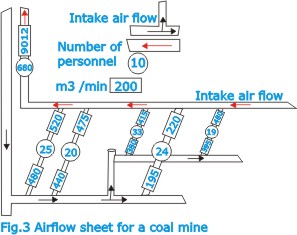Mine Ventilation |
|
|
In
between 4000 and 1200 BC, European miners dug tunnels into
chalk deposits searching for flint. Archaeological investigations
at Grimes Graves in the south of England have shown that these
early flint miners built brushwood fires at the working faces
presumably to weaken the rock. However, those Neolithic miners
could hardly have failed to observe the currents of air induced
by the fire. Indeed, the ability of fire to promote airflow
was rediscovered by the Greeks, the Romans, in medieval Europe
and during the Industrial Revolution in Britain. |
|
| The
Laurium silver mines of Greece, operating in 600 BC, have
layouts which reveal that the Greek miners were conscious
of the need for a connected ventilating circuit. At least
two airways served each major section of the mine and there
is evidence that divided shafts were used to provide separate
air intake and return connections to the surface. Underground
mines of the Roman Empire often had twin shafts, and Pliny
(AD 23-79) describes how slaves used palm fronds to waft air
along tunnels. |
|
| Ventilation
in a mine serves three main purposes: (a) to provide fresh
air for respiration by the miners, (b) to dilute any noxious
gases that may be formed underground and (c) to lower natural
heat of the rock. The underground temperature rises with increasing
depth-on an average about 1oC for every 30m (100ft.)- so that
the deeper the mine, the hotter is generally is.
|
|
 |
|
| In
simple horizontal-tunnel mining it is usually sufficient to
rely on natural ventilation by utilizing the difference in
air pressure associated with the difference in level between
two openings – the mine entrance and the top of a ventilation
shaft (Chimney effect, Fig.1). Depending on the external temperatures
prevailing at different times of the year, the direction of
flow of the draft is subject to change.
|
|
| Diffusion
(as distinct from draft) also plays some part in changing
the air in a tunnel; thus, a large-diameter tunnel can be
driven to a distance of several hundred feet without requiring
artificial ventilation. The exhaust air from pneumatic tools
is also helpful in promoting air circulation.
|
|
| In
deep mining it is necessary to use fans, that is also of very
large size. In large coal mines fresh air may have to be drawn
in at a rate of 20,000 m3 (7,00,000 ft3) per minute. These
fans are installed at the air-extraction shafts at the edge
of the mined area the main winding shaft or shafts, through
which the fresh air is drawn in, being located in the central
part of this area. With every method of ventilation the above
mentioned chimney effect is utilized as fully as possible:
the fresh air descends by gravity to the lowest levels of
the mine and is heated by the natural heat of the rock, so
that it becomes specifically lighter and tends to rise.
|
|
| |
|
 |
|
| The
rising air makes its way by various paths to suction zone
of the main extraction way or shaft, in which suction pressure
up to 400mm (17 in) water gauge are maintained. Distribution
of the fresh air over the various levels, main roadways, crossnuts,
rooms and workings is assisted by ventilation doors (designed
as air locks), stoppings, air crossings and other devices
(Fig.2 and 3).
|
|
 |
|
| Planning
of a mine-ventilation system includes the preparation of so
called air-flow sheets-diagrams comprising data on airflow
conditions. These diagrams are prepared for each section and
for the mine as a whole, the data being checked against measurements
of the actual flow underground.
|
|
For
reasons of safety the main flow has to be split up into the
largest possible number of circulating currents, and it is
essential to prevent “short circuits” –
circumstances causing the air to take a shortcut and thus
bypass certain parts of the mine. Parts that are not accessible
to the natural ventilation have to be provided with auxiliary
ventilation. For this purpose air is piped to those parts
through large-diameter ducts through which it is impelled
by powerful fans. |
|
 |
|
| This
auxiliary ventilation possesses a separate system whose proper
functioning has to be supervised and controlled with considerable
care. It may operate by suction or by pressure (blowing) or
a combination of both (Fig 4). Particularly in deep and hot
mines e.g., in South African gold mining – air conditioning
(as distinct from mere ventilation) may be used to maintain
the atmosphere of the workings at suitable temperature and
humidity for men to work in. Because of the high cost involved,
it is seldom used, however.
|
|
|
o
DISCLAIMER o
CONTACT US |